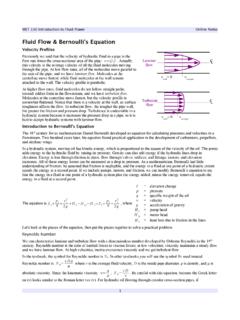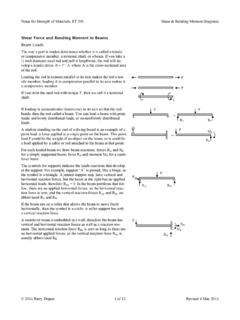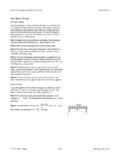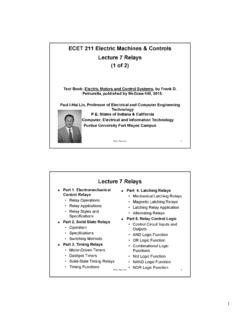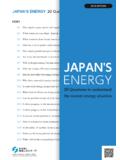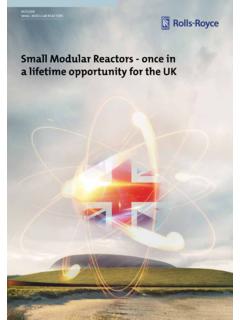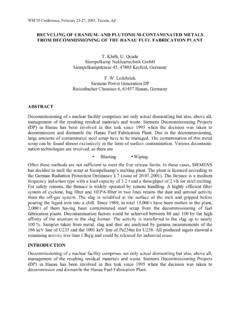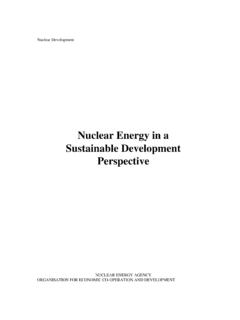Transcription of Impact Testing - IPFW
1 Materials & ProcessesOnline NotesImpact TestingHistoryIn the tensile Testing experiment, we pulled metal samples and watched them stretch until they broke in a ductile manner. If we had tested brittle materials, they would not have stretched; instead, they would have snapped suddenly. Some materials are ductile at room temperatures, while others are brittle at room we change the temperature, we can change the failure mode. Some materials that are ductile at room temperature can become brittle at low temperature (like bubble gum); other materials that are brittle at room temperature can become ductile at high temperature (like glass). We can measure this change in properties with Impact 's look at the history of Impact Testing : 1824 Publication of the first scientific paper to propose theories of Impact resistance.
2 The authors were interested in cast iron, which was widely used for structural components of machines, bridges, and buildings. 1849 Cast iron bridges in Great Britain were cracking due to the Impact loading from trains. Before the railroads, heavygoods moved by canal boat. Some canals were elevated across valleys with bridges, but the load applied to the supports did not change as a canal boat traversed the bridge, because the weight of each boat displaced an equal weight of water. Trains are different: as a heavy locomotive traverses a bridge, the supports see a greater load. The train is moving fast, so the support structure sees a sudden change in Impact load. 1857 The first Impact Testing machine was developed to test actual finished parts.
3 1898 Founding of ASTM, the American Society for Testing and Materials,1 to address railroad rail failures. ASTM is a voluntary standards organization which writes standards for materials and test procedures. 1898 Russell publishes a scientific paper on pendulum Impact testers, in which a heavy weight at the end of an armsmashes into a test specimen. At this time, there were two other types of tester in common use: [1] drop weight, in whicha heavy weight is dropped on the test specimen, and [2] flywheel, in which the momentum of a rotatin wheel is used to smash a test specimen. 1901-05 G. Charpy modified Russell s pendulum tester to accept a standardized test specimen. Prior to Charpy, impacttesting was done on finished parts, such as pipes, gun barrels, railroad rails, etc.
4 Charpy thought it made more sense to test materials than components. Once you test a particular material, you can apply the results to all the different finished products that use the material. 1933 ASTM adopted the two major pendulum test methods. 1940 The Navy became interested in Impact Testing . Here's why:This graph shows the gross tonnage of Allied shipping that was built (blue) and sunk (red).2 In the earlier part of the graph, the Axis powers were sinking ships faster than the Allies could build new ones. The Allies were taking a pounding from enemy planes, ships, and submarines, so there was a big effort to build as many ships as possible in a short timespan. The Navy organized shipyards on both coasts to build a standardized ship.
5 Everyone used the same plans, so there were economies of scale and economies of time. Instead of taking years to build, these ships eventually were completed in 2001, known as ASTM International .2 Data from (accessed 2006)1160012008004000- 400- 800 Grosstonspermonth194219431944 BuiltSunkNetMaterials & ProcessesOnline NotesThe Liberty ships were assembled in a new way. Previously, steel ships were assembled by riveting steel plates together, but the Liberty ship design called for welded plates. The reason the Navy got interested in Impact Testing is they had a problem with fracture. Liberty ships were failing at a rate of 30%. The Schenectady cracked in two the day after it It didn t can see daylight under the hull, where it broke in two.
6 The bow and the stern were heavier than the mid-ships. Many of the ships cracked in the open ocean, and returned to port missing the bow. There were reallythree problems with the hatchways were square, to make manufacturing easier. Unfortunately, these square internal corners acted as stress concentration sources of steel used in the hull contained excess sulfur and became brittle when exposed to the temperature of welds were somewhat brittle, so once a crack developed, it ran easily along the to Brittle TransitionHere s a graph that shows the transition from ductile tobrittle behavior in a low-carbon At higher temperatures, the steel can absorb a lot of Impact energy before failure. At lower temperatures, the steel absorbs a small amount of Impact energy before it fractures, so we say it s temperature range where we go from ductile to brittle behavior is the ductile-to-brittle transformation temperature.
7 Plain carbon steels are susceptible to this phenomenon. Higher carbon steels are not as resistant to re more brittle to begin with, so the effect is real but much steels with an FCC crystal structure do not suffer from ductile-to-brittle transformation, so they can be used more reliably at high and low temperatures. This is the reason stainless steel tubing isused for liquid ship fractured at the dock in Portland, OR, sitting in 40 F water. File , from Wikimedia commons, is in the public domain in the because the photograph was taken by a government employee as part of the photographer's official from Donald Askeland, The Science and Engineering of Materials, Brooks-Cole, 1984, p. ( F)Absorbedimpactenergy( ) C C steel300-series stainless steelMaterials & ProcessesOnline NotesThe hand-tool industry is interested in the brittleness ofsteels.
8 Think about a carpenter s hammer. We want thehammer head to retain its shape after many uses, so it sgot to resist deformation. At the same time, we never want the hammer head to chip, which is how it would fail in a brittle s another graph5 that shows carbon steels with a range of carbon content. We can learn several things from the graph: Low-carbon steels have higher Impact resistance than high-carbon steels. Low-carbon steels have lower ductile-to-brittle transition temperature ranges than high-carbon steels, and the ranges are narrower. There's a huge difference between and Impact energy at high temperatures popular explanation for the sinking of the Titanic is that the hull became brittle in the cold North researcher at the National Institute for Standards andTesting conducted tests on samples from the Titanic, along with modern shipbuilding He prepared specimens so they would break along the grain of the hull plates (longitudinal) and across the grain (transverse).
9 The 20 line marks a common definition of ductile-to-brittle behavior for low-carbon steels. The Titanic s hull would have been brittle in tropical oceans too. Modern steel is has a lower ductile-to-brittle transition temperature, and it has better room-temperature Impact from Smith & Hashemi, Foundations of Materials Science & Engineering, 4th ed., McGraw-Hill, 2006, p. from Tim Foecke, Metallurgy of the RMS Titanic, NIST internal report NIST-IR ( )Temperature ( F) ( F)Absorbedimpactenergy( ) 2000200400140120100806040200 Modern A36 steelTitanic hull,transverseTitanic hull,longitudinalMaterials & ProcessesOnline NotesThis Impact energy graph7 tells us 2 things:We can use heat treatment and alloying to get better Impact resistance at low s a large range of data points within any one category of material.
10 Look at mild steel at room Impact resistance ranges from 20 to 100 factor of 5 difference!The data you take in the lab experiment will include a lot of scatter. This graph shows the range of data that can occur within the same kind of material. Sources of variation include specimen preparation technique, orientation with respect to rolling direction, heat treatment, composition, and the actual radius of the base of the V-shaped s an unusual Impact graph, for pure It starts with a standard S-shaped curve, then it drops back to zero as the temperature gets higher. As we get closer tothe melting point of the metal, it gets weaker and it can t take as much same is true for steel, but we don t normally measure the Impact resistance of steel at 1400 nuclear power industry is interested in Impact Testing because exposure to temperature and radiation causes structural members in nuclear power plants to become brittle.

